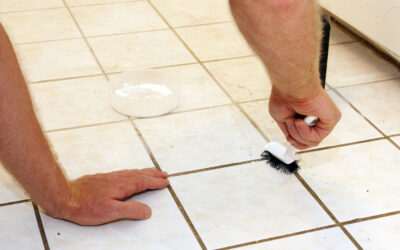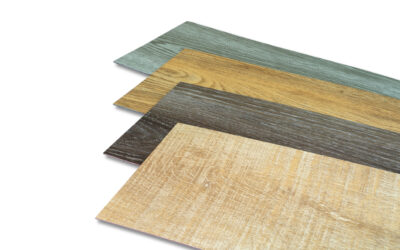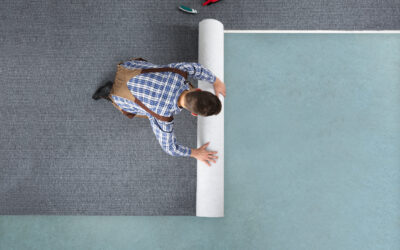Carpet Construction
Carpet
There are basically three steps to manufacturing carpet. The first step is tufting.
Tufting begins with the process of weaving the fiber into a primary backing material. The primary backing material is usually made of woven polypropylene, and its main value is to provide a base cloth to hold the yarn in place while the tufting happens.
The tufting machine looks like a big sewing machine. It has anywhere from 800 to 2000 needles working in concert to pull the yarn through the primary backing material. Loop pile products hold their appearance exceptionally well. Since there are no exposed yarn tips, only the sides of the yarn are exposed to wear and stress. Low profile loop carpet stands up to heavy traffic best.
In some carpet styles the looper then rocks back against a knife, where the small loops of yarn are cut, creating what we call a cut pile carpet. The length of these cut pieces of yarn is referred to as the pile height and is basically the distance between the looper and the primary backing.
This method of selectively cutting, called cut and loop construction, creates a recognizable pattern on the surface of the carpet.
Pile height, or nap, is the length of the tuft measured from the primary backing to the yarn tips. It is usually shown as a fraction, or sometimes its decimal equivalent. Usually shorter pile heights are more durable than longer pile heights.
The stitch rate of a carpet is the measure of how close the yarns are together. Stitch rate is measured in penetrations, or tufts, in each length of carpet, usually an inch. The stitch rate is controlled by how fast the carpet is moved through the tufting machine. Seven to eight tufts per inch is a good number, while three or four is poor.
Face weight is determined by the actual amount of fiber per square yard and is measured in ounces. A typical carpet may have a face weight of 35 to 45 ounces for example.
Finally, density is a measure of how tightly the yarn is stitched into the primary backing. Higher density carpet will typically wear better than low density carpet.
The carpet now is taken through one of two dyeing processes.
The first method of dyeing is called yarn dyeing, or sometimes pre-dyeing, where the color is applied to the yarn prior to tufting. The advantages of all yarn dyeing methods include good side-by-side color consistency, large lot sizes, and uniformity.
The second method involves applying color to the yarn after the carpet has been tufted. This method is called carpet dyeing. There are several carpet dyeing methods in use, each producing a unique result.
The first technique, often referred to as Beck, or batch dyeing, involves stitching the ends of the carpet together, and then running the tufted carpet loop through large vats of dye and water for several hours. The Beck process is ideal for smaller production runs, and heavier face weight products.
Continuous dyeing is a similar process to Beck dyeing but involves running the carpet through several processes in addition to just the dye application. Continuous dyeing applies the color directly to the carpet face by spraying or printing. This process is also used to create multicolor or patterned effects in the carpet.
Screen printing is another common method of carpet coloring, where color is applied through anywhere from one to as many as eight silk-screens. The major benefits of carpet dyeing, that is dyeing the carpet after the tufting process, are greater color flexibility, and lower cost.
The next step in the manufacturing process is the finishing process. In the finishing process, a coating of latex is applied to both the tufted, dyed carpet’s primary backing, and also to secondary backing. Secondary backing is typically made of a woven synthetic polypropylene material. The two parts are squeezed together in a large heated press, where they are held firmly to preserve their shape.
Shearing, one of the last stages in the manufacture of carpet, is the process of removing all the little loose ends and projecting fibers that might have been created during the tufting process. It also helps achieve the yarn’s tip definition of the finished carpet.
Finally, each carpet is carefully inspected for color uniformity and other manufacturing defects before it is rolled, wrapped, and shipped.
Carpet Menu
SHARE THIS ON SOCIAL MEDIA
Recent Posts
Tips for Cleaning the Grout in Your Tile Floors
Tuesday, October 25, 2022
Tile is resistant to stains, but over time the grout can begin to look grimy. Regardless of whether you have porcelain, ceramic, or natural stone tile, here are some tips for renewing your tile grout. Cleaning ProductsThere are numerous grout cleaning products on the...
Buying Guide for Luxury Vinyl Tile
Wednesday, October 19, 2022
Luxury vinyl tile (LVT) is an excellent flooring option not only because of its durability and water resistance, but because it closely mimics wood, making it a great style choice for any home. Here’s your guide for choosing the best LVT flooring. MaterialThe two main...
The Top 3 Flooring Options for Busy Families
Wednesday, October 12, 2022
When you have a young, busy family, you know that cleaning can take up a lot of time. Choosing the right flooring can significantly simplify your life. Here are the top 3 options to consider. HardwoodSome homeowners may initially shy away from hardwood simply because...
Improving Your Allergies with Hardwood Floors
Wednesday, October 05, 2022
Do you suffer from allergies? Did you know your home’s flooring can impact the severity of your allergies as much as what’s in the air? Hardwood flooring is a great option to help cut back on your symptoms. No Trapped IrritantsOne reason hardwood floors are allergy...
What to Expect with Professional Carpet Installation
Tuesday, September 27, 2022
Are you getting new carpet in your home? Professional installation is important to ensure proper installation so that the carpet will last as long as possible. Here’s what to expect with professional carpet installation. Installation PreparationFirst of all, the...





